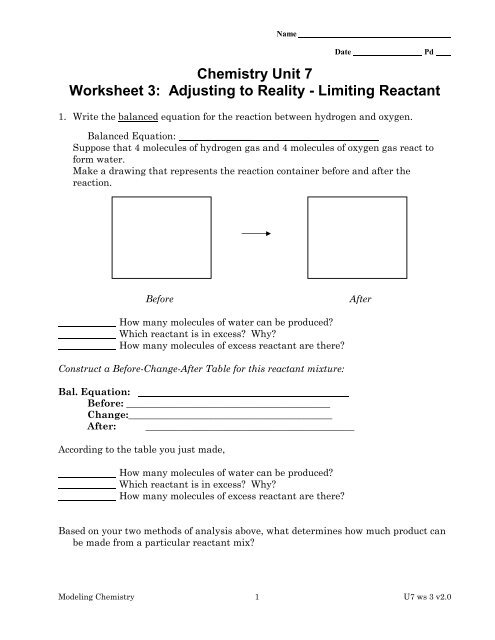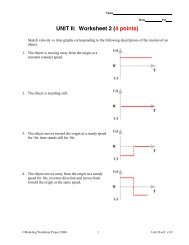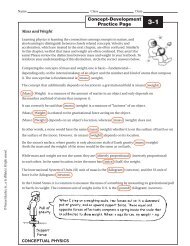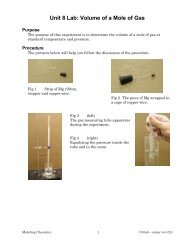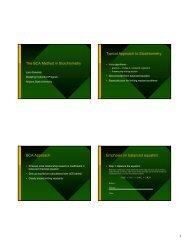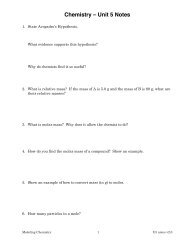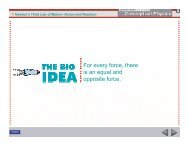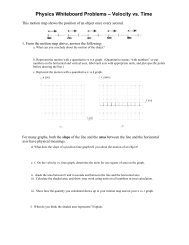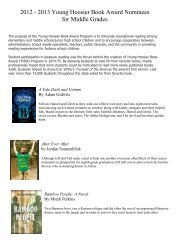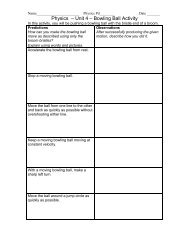Chemistry Unit 7 Worksheet 3: Adjusting to Reality - Limiting Reactant
Chemistry Unit 7 Worksheet 3: Adjusting to Reality - Limiting Reactant
Chemistry Unit 7 Worksheet 3: Adjusting to Reality - Limiting Reactant
Create successful ePaper yourself
Turn your PDF publications into a flip-book with our unique Google optimized e-Paper software.
Name<br />
<strong>Chemistry</strong> <strong>Unit</strong> 7<br />
<strong>Worksheet</strong> 3: <strong>Adjusting</strong> <strong>to</strong> <strong>Reality</strong> - <strong>Limiting</strong> <strong>Reactant</strong><br />
1. Write the balanced equation for the reaction between hydrogen and oxygen.<br />
Balanced Equation: __________<br />
Suppose that 4 molecules of hydrogen gas and 4 molecules of oxygen gas react <strong>to</strong><br />
form water.<br />
Make a drawing that represents the reaction container before and after the<br />
reaction.<br />
Date<br />
Pd<br />
Before<br />
After<br />
How many molecules of water can be produced?<br />
Which reactant is in excess? Why?<br />
How many molecules of excess reactant are there?<br />
Construct a Before-Change-After Table for this reactant mixture:<br />
Bal. Equation:<br />
Before: __________________________________________<br />
Change:__________________________________________<br />
After: ___________________________________________<br />
According <strong>to</strong> the table you just made,<br />
How many molecules of water can be produced?<br />
Which reactant is in excess? Why?<br />
How many molecules of excess reactant are there?<br />
Based on your two methods of analysis above, what determines how much product can<br />
be made from a particular reactant mix?<br />
Modeling <strong>Chemistry</strong> 1 U7 ws 3 v2.0
2. Write the equation for the formation of ammonia from nitrogen gas and hydrogen<br />
gas.<br />
Balanced Equation:<br />
Given 6 molecules of nitrogen and 12 molecules of hydrogen, make a drawing that<br />
represents the reaction container before and after the reaction.<br />
Before<br />
After<br />
How many molecules of ammonia can be produced?<br />
Which reactant is in excess? Why?<br />
__________ How many molecules of excess reactant are there?<br />
Construct a Before-Change-After Table for this reactant mixture:<br />
Bal. Equation:<br />
Before: __________________________________________<br />
Change:__________________________________________<br />
After: ___________________________________________<br />
According <strong>to</strong> the table you just made,<br />
How many molecules of ammonia can be produced?<br />
Which reactant is in excess? Why?<br />
How many molecules of excess reactant are there?<br />
Describe what you must look for in a particular reactant mixture <strong>to</strong> decide which<br />
reactant will be in excess (have some left over after the reaction):<br />
Modeling <strong>Chemistry</strong> 2 U7 ws 3 v2.0
3. When 0.50 mole of aluminum reacts with 0.72 mole of iodine <strong>to</strong> form aluminum<br />
iodide, how many moles of the excess reactant will remain? ____________<br />
How many moles of aluminum iodide will be formed? _____________<br />
Bal. Equation:<br />
Before: __________________________________________<br />
Change:__________________________________________<br />
After: ___________________________________________<br />
4. When sodium hydroxide reacts with sulfuric acid (H2 SO 4 ), water and sodium<br />
sulfate are the products. Calculate the mass of sodium sulfate produced when<br />
15.5 g of sodium hydroxide are reacted with 46.7 g of sulfuric acid. [Hint: which unit<br />
is used in all s<strong>to</strong>ichiometry reasoning?]<br />
5. A 14.6 g sample of oxygen gas is placed in a sealed container with 2.5 g of hydrogen<br />
gas. The mixture is sparked, producing water vapor. Calculate the mass of water<br />
formed. Calculate the number of moles of the excess reactant remaining.<br />
6. Neuroscientists believe that the only chemical in chocolate that<br />
may have a feel-good effect on the human brain is<br />
phenylethylamine (PEA). Although the PEA in chocolate occurs<br />
naturally, PEA can be made in the labora<strong>to</strong>ry by the following<br />
reaction:<br />
phenylethylamine<br />
CH5NO2 + C8H8O C8H11N + CO2 + H2O<br />
ammonium formate ace<strong>to</strong>phenone phenylethylamine<br />
(PEA)<br />
How much PEA can be made from 75.0g of ammonium formate and 125g of ace<strong>to</strong>phenone?<br />
What mass of the excess reactant remains?<br />
4. 27.5 g 5. 16.4 g, 0.34 moles xs 6. 126 g, 9.45g xs<br />
Modeling <strong>Chemistry</strong> 3 U7 ws 3 v2.0


